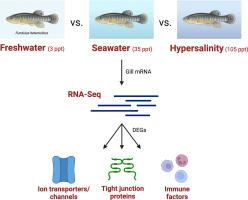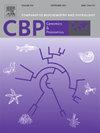木乃伊(Fundulus heteroclitus)对高盐度的耐受性:分支转录组分析
IF 2.2
2区 生物学
Q4 BIOCHEMISTRY & MOLECULAR BIOLOGY
Comparative Biochemistry and Physiology D-Genomics & Proteomics
Pub Date : 2024-10-10
DOI:10.1016/j.cbd.2024.101338
引用次数: 0
摘要
在北美东海岸,木乃伊鱼(Fundulus heteroclitus)的近岸栖息地盐度范围很广。然而,有关木曼克鱼(以及其他高渗透耐受性鱼类)在高于海水(SW)的环境盐度下生存的分子和细胞过程的信息却很少。为了揭示它们异常广泛的耐盐性背后的分支过程,我们进行了一项RNA-Seq分析,以确定在3、35和105 ppt条件下生活的木乃伊鱼的差异表达基因(DEGs)。我们发现了一系列以前与淡水(FW)和SW型离子细胞相关的DEGs;然而,在35和105 ppt条件下,anoctamin 1a(一种Ca2+激活的Cl-通道)的表达增加,这表明在木乃伊的SW型离子细胞中可能存在一种未被描述的Cl-分泌途径。关于 FW 适应性分支过程,我们发现 claudin 5a 是一种基因,其产物可能会限制离子在细胞紧密连接之间的扩散损失。此外,针对高盐条件,我们发现了与肌醇合成和激酶信号转导相关的 DEGs。这项研究为未来的生理学研究提供了新的分子靶标,有望揭示木乃伊鼠和其他极海洋物种如何耐受高盐度条件的机理基础。本文章由计算机程序翻译,如有差异,请以英文原文为准。

Hypersalinity tolerance of mummichogs (Fundulus heteroclitus): A branchial transcriptomic analysis
Along the east coast of North America, mummichogs (Fundulus heteroclitus) are subjected to a broad range of salinities in their nearshore habitats. However, there is a paucity of information regarding the molecular and cellular processes that mummichogs (and other highly osmotolerant fishes) engage to survive environmental salinities greater than seawater (SW). To reveal branchial processes underlying their extraordinarily broad salinity tolerance, we performed an RNA-Seq analysis to identify differentially expressed genes (DEGs) in mummichogs residing in 3, 35, and 105 ppt conditions. We identified a series of DEGs previously associated with both freshwater (FW)- and SW-type ionocytes; however, the heightened expression of anoctamin 1a, a Ca2+-activated Cl− channel, in 35 and 105 ppt indicates that an undescribed Cl−-secretion pathway may operate within the SW-type ionocytes of mummichogs. Concerning FW-adaptive branchial processes, we identified claudin 5a as a gene whose product may limit the diffusive loss of ions between cellular tight junctions. Further, in response to hypersaline conditions, we identified DEGs linked with myo-inositol synthesis and kinase signaling. This study provides new molecular targets for future physiological investigations that promise to reveal the mechanistic bases for how mummichogs and other euryhaline species tolerate hypersaline conditions.
求助全文
通过发布文献求助,成功后即可免费获取论文全文。
去求助
来源期刊
CiteScore
5.10
自引率
3.30%
发文量
69
审稿时长
33 days
期刊介绍:
Comparative Biochemistry & Physiology (CBP) publishes papers in comparative, environmental and evolutionary physiology.
Part D: Genomics and Proteomics (CBPD), focuses on “omics” approaches to physiology, including comparative and functional genomics, metagenomics, transcriptomics, proteomics, metabolomics, and lipidomics. Most studies employ “omics” and/or system biology to test specific hypotheses about molecular and biochemical mechanisms underlying physiological responses to the environment. We encourage papers that address fundamental questions in comparative physiology and biochemistry rather than studies with a focus that is purely technical, methodological or descriptive in nature.

 求助内容:
求助内容: 应助结果提醒方式:
应助结果提醒方式:


